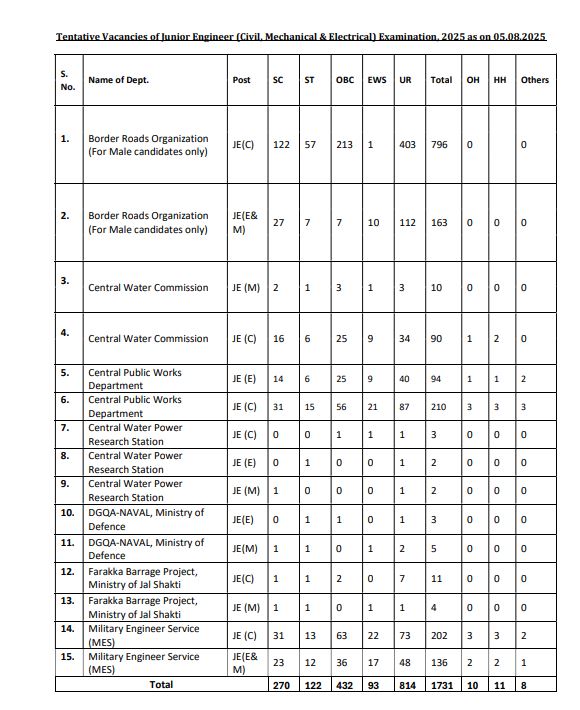Table of Contents
The SSC JE 2025 exam has become even more significant with the latest vacancy update. SSC has now released 1,731 vacancies, an increase from earlier estimates. This boost in post count directly impacts aspirants by offering better selection chances across major engineering streams. Candidates are advised to review the department-wise and branch-wise details to align their preparation with the latest trends.
SSC JE 2025 Vacancy Increased: Now 1700+ Posts Released!
In a major update for engineering aspirants, the Staff Selection Commission (SSC) has officially increased the number of vacancies for the SSC JE 2025 recruitment. As per the latest notification released on 5th August 2025, the total number of Junior Engineer (JE) posts has now reached 1,731 across various central government departments. This is a significant rise from the earlier tentative figures and reflects an increased demand for Civil, Electrical, and Mechanical engineers in core technical departments.

SSC JE 2025 Branch-Wise Vacancy Details
The Staff Selection Commission has released a detailed breakup of the 1,731 vacancies for the SSC JE 2025 recruitment, categorized by engineering branches. As expected, the Civil Engineering stream has received the highest number of posts, followed by Electrical, Mechanical, and Electrical & Mechanical (E&M) combined categories.
Below is an approximate branch-wise vacancy distribution based on the official data:
- Civil Engineering (JE Civil): More than 1,300 vacancies
- Mechanical Engineering (JE Mechanical): Around 160 vacancies
- Electrical Engineering (JE Electrical): Nearly 200 vacancies
- Electrical & Mechanical (JE E&M): Close to 160 vacancies
What This Vacancy Hike Means for Aspirants?
The increase in SSC JE 2025 vacancies to 1,731 posts is a significant boost for engineering aspirants preparing for government jobs. This hike not only widens the scope of selection but also reflects the growing demand for technical talent in key infrastructure and development sectors of the central government.
With more positions now available, the competition-per-seat ratio is expected to improve, giving well-prepared candidates a better chance of securing a position. Aspirants who may have been discouraged by the initially lower vacancy count now have renewed motivation to intensify their preparation and aim for top-performing departments like CPWD, BRO, MES, and CWC.




 OSSC JE Eligibility Criteria 2026, Check...
OSSC JE Eligibility Criteria 2026, Check...
 DRDO CEPTAM 11 Apply Online 2025 Starts,...
DRDO CEPTAM 11 Apply Online 2025 Starts,...
 BEL Probationary Engineer Selection Proc...
BEL Probationary Engineer Selection Proc...





